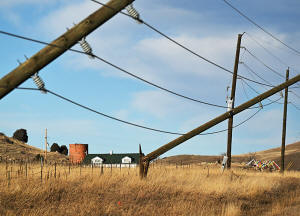Hurricane-force wind downs power lines, fans wildfires in Colorado with
more on way
[December 19, 2025]
By MEAD GRUVER
FORT COLLINS, Colo. (AP) — Crews were mopping up Thursday but still
bracing for more after hurricane-force wind downed power lines and
fanned wildfires along the Colorado Front Range and onto the Great
Plains.
Wind that in places topped 100 mph (160 kph) late Wednesday arrived
after Xcel Energy protectively cut off power through much of its eastern
Colorado service areas. The goal was to prevent downed lines from
starting fires — and power lines were indeed blown down in several
areas.
By Thursday afternoon, power was about 60% restored to the almost 700
miles (1,100 kilometers) of power lines the utility de-energized. Some
37,000 Xcel customers on the Front Range and into the Rocky Mountains
were still without power.
Another round of outages was expected Friday, however, with a forecast
for even stronger winds over a longer period.
While crews worked to restore power to customers already affected, even
longer outages were likely Friday, the head of Xcel Energy-Colorado
cautioned in a news conference.
“The power will not come back on the moment the wind event ends because
we have to inspect the lines,” said the utility's president, Robert
Kenney.
In central Denver, the power was out overnight, furniture was blown off
apartment balconies, at least one apartment window was blown out and the
ground was littered with blown-down branches Thursday.
Winds on Wednesday afternoon and into Thursday fanned wildfires of
still-undetermined cause in eastern Colorado, burning at least 14,000
acres (5,700 hectares) in Yuma County, local emergency management
officials said in a Facebook post.

A grass fire on the south side of Cheyenne, Wyoming, prompted a
neighborhood's evacuation for several hours Wednesday evening. No
structures burned, however.
Powerful gusts Thursday prompted closures of Interstates 25 and 80 in
southeastern Wyoming to lightweight, high-profile vehicles though not
other traffic. Unladen tractor-trailers whose drivers ignore such
warnings are often seen blown over on the windy state's highways,
prompting jokes that the trucks are just taking a rest.

[to top of second column]
|

Power poles along U.S. Highway 93 near Golden, Colo., snapped in
half during a strong wind storm on Wednesday, Dec. 17, 2025. (Photo
by RJ Sangosti/The Denver Post via AP)

“If your commercial hauler is in need of a good night’s sleep we would
highly recommend the windblown plains of I-80, I-25, or I-90,” the
Wyoming Highway Patrol joked on Facebook, adding: “For the low, low cost
of a Driving on Closed Roads Citation ($1,000+).”
High winds and red flag fire warnings were in effect, meanwhile, across
much of Kansas on Thursday. Blowing dust reduced visibility so much that
a stretch of Interstate 70 near the state’s western line with Colorado
closed, the Kansas Department of Transportation said in a news release.
The release urged motorists to consider delaying non-essential travel.
In the Pacific Northwest, heavy rain continued falling along with snow
in the mountains. Rivers in Washington had fallen since recent flooding
inundated communities, damaged roads and prompted more than 600 rescues.
Parts of southern Oregon and northern California including the San
Francisco Bay area were expected to see several inches (centimeters) of
rain and strong winds Friday and into the weekend.
Then on Christmas Eve, a Pineapple Express, a stronger atmospheric river
that originates in the tropics near Hawaii, could arrive in northern
California. The forecast brought hope to ski resort operators that much
anticipated precipitation will extend into the Sierra Nevada, where very
little snow has fallen this season.
Elsewhere, a blizzard was bringing as much as 8 inches (20 centimeters)
of snow to northern North Dakota and Minnesota before it heads into
Wisconsin and other areas eastward over the next couple days.
___
Heather Hollingsworth in Kansas City; Christopher Weber in Los Angeles;
Gene Johnson in Seattle; Jack Dura in Bismarck, N.D.; and David
Zalubowski in Denver contributed.
All contents © copyright 2025 Associated Press. All rights reserved |